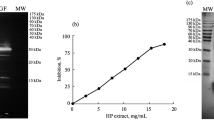Abstract
Esterases from the digestive gland of the snails Lanistes carinatusand Lanistes boltenicollected from four Egyptian governorates were extracted and analyzed using starch gel electrophoresis and five substrates. Twelve esterase bands were detected in both Lanistes species. The esterase bands were distributed in three main zones, which could be classified as acetylesterases, carboxylesterases, and cholinesterases. Depending on the substrate specificity, inhibition properties, and relative mobility of esterase bands, the three zones of esterase activity could be traced to eight genetic loci. Locality-specific loci were found. Inter- and intrapopulation variations are discussed. There is an absence of equilibria at all esterase loci in all populations studied, and a high proportion of genetic diversity in different esterase loci. The absence of interspecific variations proves that Lanistessnails in Egypt belong to one species.
Similar content being viewed by others
REFERENCES
Abdelmordy, M. B. (1984). Isozyme Polymorphism of Esterases in Syrian Hamster, Ph.D. thesis, Fac. Sci., Ain Shams Univ., Cairo, Egypt.
Augustinsson, K. B. (1961). Multiple forms of esterases in vertebrate blood plasma. Ann. N.Y. Acad. Sci. 94:844.
Demian, E. S. (1958). On the respiratory system and the mechanism of respiration in Lanistes bolteni Chemnitz, 1786. Ain Shams Sci. Bull. 3:301.
Haites, N., Don, M., and Masters, C. J. (1972). Heterogeneity and molecular weight inter-relationships of the esterase isoenzymes of several invertebrate species. Comp. Biochem. Physiol. 42B:303.
Malek, E. A., and File, S. K. (1971). Electrophoretic studies on the digestive gland esterases of some biomphalarid and lymnaeid snails. Bull. WHO 45:819.
Matteo, M. R. (1975). Biochemical characterization of esterase isozymes of the marine snail, Littorina littorea. In Market, C. L. (ed.), Isozymes IV: Genetics and Evolution, Academic Press, New York.
May, B. (1992). Starch gel electrophoresis of allozymes. In Hoelzel, A. R. (ed.), Molecular Genetic Analysis of Populations, a Practical Approach, Oxford University Press, Oxford, New York, Tokyo.
Mulvey, M., Goater, T., Esch, G., and Crews, A. (1987). Genotype frequency differences in Halipegus occidualis-infected and uninfected Helisoma anceps. J. Parasitol. 73(4):757.
Narang, S., and Narang, N. (1974). Characterization of malate dehydrogenase: Electrophoresis, isoelectric focusing, thermostability, inhibition and activity studies on homogenates of various organs of Biomphalaria glabrata (Mollusca: Pulmonata). Comp. Biochem. Physiol. 49B:477.
Oxford, G. S. (1973a). The genetics of Cepaea esterases. I. Cepaea nemoralis. Heredity 30(2): 127.
Oxford, G. S. (1973b). The biochemical properties of esterases in Cepaea (Mollusca: Helicidae). Comp. Biochem. Physiol. 45B:529.
Oxford, G. S. (1973c). The molecular weight relationships of esterases in Cepaea nemoralis and C. hortensis (Mollusca: Helicidae) and their genetical implications. Biochem. Genet. 8:365.
Reid, R. G. (1968). The distribution of digestive tract enzymes in lamellibranchiate bivalves. Comp. Biochem. Physiol. 24B:727.
Reid, R. G., and Dunnill, R. M. (1969). Specific and individual differences in the esterases of members of the genus Macoma. Comp. Biochem. Physiol. 29B:601.
Richmond, R., and Powell, J. R. (1970). Evidence of heterosis associated with an enzyme locus in a natural population of Drosophila. Proc. Natl. Acad. Sci. USA 67:1264.
Selander, R. K., and Foltz, D. W. (1981). Gametic disequilibrium between esterase loci in populations of Cepaea nemoralis in western New York. Evolution 35:190.
Selander, R. K., Hunt, W. G., and Yang, S. Y. (1969). Protein polymorphism and genic heterozygosity in two European subspecies of the house mouse. Evolution 23:379.
Talesa, V., Contenti, S., Mangiabene, C., Pascolini, R., Rosi, G., and Principato, G. B. (1990). Propionylcholinesterase from Murex brandaris: Comparison with other invertebrate cholinesterase. Comp. Biochem. Physiol. (C) 96(1):39.
Vuilleumier, F., and Matteo, M. R. (1972). Esterase polymorphisms in European and American populations of the periwinkle, Littorina littorea (Gastropoda). Experientia 28:1241.
Wahren, H., and Tegelström, H. (1973). Polymorphism of esterases and tetrazolium oxidases in the Roman snail, Helix pomatia: A study of populations from Sweden and Germany. Biochem. Genet. 9(2):169.
Wang, X. (1994). Analysis of electrophoretic patterns of three enzymes of Oncomelania hupensis. J. Parasitol. Parasit. Diseases 12(4):271.
Author information
Authors and Affiliations
Rights and permissions
About this article
Cite this article
Abdelmordy, M.B., Sleem, S.H. & Tantawi, T.A. Isozyme Polymorphism of Esterases in the Genus Lanistes (Mollusca: Prosobranchiata) and Genetic Analysis of Populations. Biochem Genet 35, 77–89 (1997). https://doi.org/10.1023/A:1022204123584
Issue Date:
DOI: https://doi.org/10.1023/A:1022204123584




